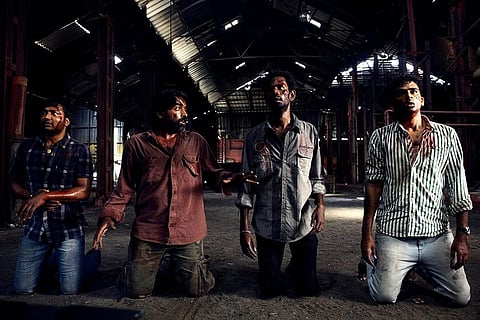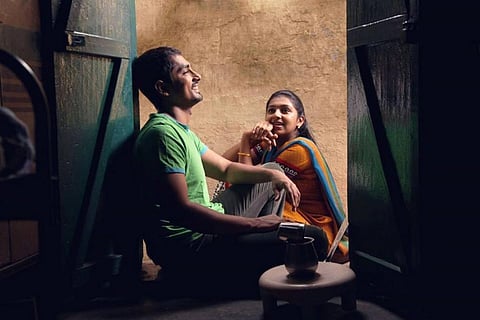Crow’s Egg Platter
Reel In Some Jigarthanda!
A pyrotechnical burst of creativity—with grit, grunge and realism—is lighting up the cinemas
- Pizza (2012)
Directed by: Karthik Subbaraj
A thriller about a pizza delivery boy. Subbaraj’s next was Jigarthanda (2014). His Iraivi opened last week.
- Visaranai (2016)
Directed by: Vetrimaaran
Tells the story about a group of migrant workers picked up by the police and the system at work. Vetrimaaran is famed for his iconic Aadukaalam.
- Kaaka Muttai (2015)
Directed by: M. Manikandan
About two slum kids longing to have a pizza. Manikandan’s latest, Kutrame Thandanai, premiered this year at a fest.
- Soodhu Kaavum (2013)
Directed by: Nalan Kumarasamy
A dark comedy about a kidnapping. Kadhalum Kadanthu Pogum, his rom-com, released this year.
***
Somewhere towards the middle of the Tamil film Visaranai (or Interrogation), an influential auditor intones patronisingly to the cop questioning him: “Systemdhaan perisse, naamba verum pawns (The system is bigger than all of us, we are mere pawns.)” A new crop of films rolling out of Kodambakkam is in fact bucking the system, giving Tamil cinema a hard edge. For instance, Visaranai, directed by Vetrimaaran, who won a national award for the iconic Aadukalam, drags audiences into the innards of a police station and makes them feel the thwack of the lathi.
Okay, there are lots of masala flicks still being made and you can argue that Tamil cinema’s repository of pathbreaking filmmakers has regularly turned out bold stuff, perhaps bolder than what we are seeing now. So what’s new now? Plenty, by the looks of it. And much of it from a bunch of young filmmakers, some so new they haven’t worked up the ranks in the traditional way but make movies that are stylish, entertaining, non-preachy—and have carved a market for themselves.
It didn’t happen overnight; nor is the new-gen realism pioneering. This recent renaissance began, as J. Hurtado, a film critic who writes for Twitch Film, puts it, when young filmmakers began mixing these elements of realism with the accepted tropes of Tamil cinema. Films like Subramaniapuram (2008), Paruthiveeran (2007), Aadukalam (2011) and the rest of the Tamil gangster films were a great start. “But it seems filmmakers have turned a corner with new films—like Kirumi, Jigarthanda and Soodhu Kavvum—which take elements from crime films and bend them to be more commercial,” says Hurtado. What helps, he says, is that Tamil cinema audiences are willing to stretch for a good film. Besides, there are heroes like Dhanush and Vijay Sethupathi, who don’t inspire rabid devotion but are yet nationally recognised as quality actors.

From Soodhu Kaavum
“These films tell stories stylishly, cleverly, don’t shy away from violence and their narratives are very unlike commercial cinema tropes. Yet, they find an appreciative audience at the box office,” says Naman Ramachandran, a London-based movie critic and author of Rajinikanth: The Definitive Biography. “The so-called new wave should actually be called the new new wave because the movement is more than a decade old,” he says, tracing it to Balaji Sakthivel’s Kaadhal (2004) and continuing through with Selvaraghavan’s Pudhupettai (2006) and Vasanthabalan’s Veyyil (2006) before the scene really exploded. It’s had an impact on other cinema, too. Anurag Kashyap’s Gangs of Wasseypur opens with a dedication to directors Bala, Ameer and M. Sasikumar, notes Ramachandran. The grammar of Marathi new wave hits, too, is informed by the Tamil new wave, he says. There’s a vibrancy in Malayalam films brought by mind-bogglingly diverse tales and an incipient new wave in Kannada too.
“Tamil new wave films are unique in India because they are the ones most willing to make the film they want to make with minimal commercial restraints. Bollywood makes gangster films too, but they need big names, and the same goes for Telugu films,” says Hurtado, who ranks Tamil as his favourite regional cinema in the world. “There is something special happening, and thankfully it’s being allowed to grow at its own pace.” And Tamil churns out probably as many films a year as Bollywood.
It’s usually very tricky to recover money from Hindi films just by running in theatres, whereas regional cinema may be more forgiving because their marketing costs are lower. “Very, very few (Hindi) movies recover money from the box office. Perhaps their international sales may be the saving grace for some of them,” says Punit Thakkar of Sikhya Entertainment, the production house which made the Hindi film Lunch Box (2013). But that doesn’t take away from the fact that what we’re talking about is really well-made films. Sikhya represented Visaranai at the Venice film festival last year and at other venues. Every year now, Thakkar says, more Indian films are opening at top film festivals across the world.

Jigarthanda is named after a milk-based cold drink from Madurai
“If I want to focus on one point about the new Tamil films, I think it’s about storytelling,” says film critic Sundar Sarukkai. “It’s not just storytelling about the rural etc, because we already saw it with Bharathiraja, Bhagyaraja...you know, enormously influential movies at that time. It’s not even about stories of the underbelly,” he says. Of course, that’s there as well. The Siddarth-starrer Jigarthanda (2014) giving a dark, comic twist to the story of an aspiring filmmaker, who, asked to make a film about gangsters, packs his bags for Madurai. “There’s a kind of matter-of-factness about things without adding huge, grand, narratives...like you don’t have to add moral stories and stuff like that.” Take Kaaka Muttai (Crow’s Egg), the film about two children from a slum lusting for a pizza, for instance. “Kaaka Muttai was a phenomenal film in the sense that it was able to do many things at different levels. There’s no sentimentality about the two kids, you don’t have sad songs in the background, you don’t feel like crying for the two kids,” says Sarukkai. The film, directed by M. Manikandan and produced by actor Dhanush and Vetrimaran, won the national award for best children’s film in 2015. Manikandan’s latest is Kutrame Thandanai (The Crime Itself is the Punishment) which premiered at the New York Indian film festival last month.
What Sarukkai finds equally interesting is that there are lots of competent short films on YouTube made by completely unknown names as well as the upcoming directors. Actually, that’s the route many of Tamil cinema’s new faces have taken, much like in the West where, historically, short films have been a calling card for filmmakers. Many, like Karthik Subbaraj (who made Pizza in 2012 and followed up with Jigarthanda), haven’t spent long years on the sets before venturing into their first film. But they’ve been actively making short films. Karthik, 33, who’s latest film Iraivi was released last week, now also runs Stonebench, a company which gives independent short filmmakers a platform through the brand Benchflix.com. In the past year, the firm has released two films, Bench Talkies and Aviyal, both low-budget (marketing-wise) anthologies of short films made by various indie directors, in theatres (Aviyal played on nearly 100 screens in Tamil Nadu and Kerala).
Kalyan Subramanian, who heads marketing for Stonebench, says that through shorts, there’s now a self-learning of the skills required to become a feature filmmaker without apprenticeship to a director. He says that in the last five years, 10-15 short filmmakers have graduated to feature films. This has happened because the scenario has changed and producers are open-minded about backing newcomers if there is a strong storyline.
Hurtado agrees and says, “Someone like C.V. Kumar has made a living by giving chances to filmmakers who would’ve normally been stopped dead in their tracks.” As the critics put it, may their tribe increase.
Tags